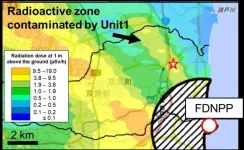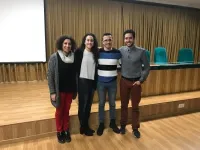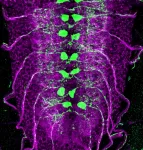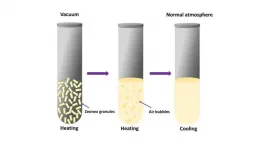Global mapping projects aid humanitarian organisations
Heidelberg University geoinformation scientists study the evolution of humanitarian mapping
2021-02-17
(Press-News.org) In recent years, free digital world maps like OpenStreetMap (OSM) have become a vital instrument to support humanitarian missions over the entire world. In disaster management as well as the implementation of the United Nations Sustainability Development Goals (SDGs), geodata compiled by the volunteer mapper community open up new possibilities to coordinate aid interventions and carry out sustainability projects. The mapping data are collected either locally using a smartphone and GPS device or on the basis of satellite images. An international team of researchers led by geoinformation scientists based at Heidelberg University is studying the evolution of humanitarian mapping and its repercussions on OpenStreetMap.
Digital services and platforms like the "HOT Tasking Manager" are used to coordinate the activities of volunteer mappers in all parts of the world as well as used by aid organisations to better respond to humanitarian disasters. "In recent years, the HOT Tasking Manager has become a vital tool for humanitarian mapping. Until now, however, there has been no comprehensive study on its effects or how it influences the overall development of OpenStreetMap and the make-up of the incorporated data," explains Benjamin Herfort, a doctoral candidate in the Geoinformatics Department at the Institute of Geography of Heidelberg University and research assistant at the Heidelberg Institute for Geoinformation Technology (HeiGIT), which is supported by the Klaus Tschira Foundation.
The first long-term study of all humanitarian mapping projects in the "HOT Tasking Manager" indicates that between January 2008 and May 2020 more than 60 million buildings and over four million roads were added to OpenStreetMap, primarily in regions with low and medium human development. This form of humanitarian mapping thus actively contributes to the diversification of mapping activities and the geodata in OpenStreetMap. "However, a strong focus on the Global North still persists," states Benjamin Herfort. "In spite of the progress over recent years, regions which, according to the Human Development Index, are considered to have low and medium human development account for only 28 percent of buildings labelled on OpenStreetMap and only 16 percent of mapped streets - although half of the world's population lives there."
This inequality is largely founded in socio-economic and demographic factors. At the same time, variables like sudden natural disasters play a major role. They can launch a spate of humanitarian mapping activities, as seen for the first time in 2010 after the earthquake in Haiti. On the other hand, local and regional factors can impede humanitarian mapping, especially if there is no Internet access.
According to the study, humanitarian mapping with the "HOT Tasking Manager" has an overall positive impact on the geographical distribution of global mapping activities in OpenStreetMap. Additional studies are already being planned to bring to light the development of all humanitarian mapping activities in OSM including beyond the "HOT Tasking Manager". Based on their current analyses, however, the researchers have already identified opportunities for further development. They recommend that the humanitarian mapper community and participating organisations shift their priority from documenting completed mapping activities to specifically evaluating regions from which more data is needed. They also encourage taking a long-term view of mapping projects with a humanitarian focus, apart from acute events like natural disasters. Local mapper communities would then form in affected or vulnerable regions that would continually maintain data in the OpenStreetMap, keeping these regions visible on the map. Further, the researchers support simplifying local data collection by strengthening the technical infrastructure and engaging as many different social groups as possible in map-making. Benjamin Herfort: "This approach supports participation and opens up new local perspectives, thereby creating potential for development."
INFORMATION:
Scientists from the University of Warwick (United Kingdom) and the University of Colorado in Boulder (USA) also participated in the study. The research was funded by the Klaus Tschira Foundation; publication in open-access format was made possible by the DEAL project. The results of the study were published in the journal "Scientific Reports".
[Attachments] See images for this press release:
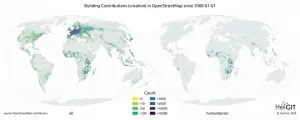
ELSE PRESS RELEASES FROM THIS DATE:
2021-02-17
The 10 year anniversary of the Fukushima Daiichi nuclear accident occurs in March. Work just published in the Journal 'Science of the Total Environment' documents new, large (> 300 micrometers), highly radioactive particles that were released from one of the damaged Fukushima reactors.
Particles containing radioactive cesium (134+137Cs) were released from the damaged reactors at the Fukushima Daiichi Nuclear Power Plant (FDNPP) during the 2011 nuclear disaster. Small (micrometer-sized) particles (known as CsMPs) were widely distributed, reaching as far as Tokyo. CsMPs have been the subject of many studies in recent years. However, it recently became apparent that larger (>300 micrometers) Cs-containing particles, with much higher levels of activity (~ 105 Bq), were also ...
2021-02-17
The brain's neural activity is irregular, changing from one moment to the next. To date, this apparent "noise" has been thought to be due to random natural variations or measurement error. However, researchers at the Max Planck Institute for Human Development have shown that this neural variability may provide a unique window into brain function. In a new Perspective article out now in the journal Neuron, the authors argue that researchers need to focus more on neural variability to fully understand how behavior emerges from the brain.
When neuroscientists investigate the brain, its activity seems to vary all the time. Sometimes activity is higher or lower, rhythmic or irregular. Whereas averaging brain activity ...
2021-02-17
The researchers analysed how Spanish children and adolescents get to school, based on studies examining the commuting patterns of 36,781 individuals over a 7-year period (2010-2017)
Researchers from the University of Granada (UGR) have conducted the most comprehensive study to date on how Spanish children and young people get to school each day, to determine the active commuting rate.
The results showed that, between 2010 and 2017, in the region of 60% of Spanish children and adolescents actively commuted to school, with no significant variations being observed during this period.
The study, which was recently ...
2021-02-17
Our brains are complicated webs of billions of neurons, constantly transmitting information across synapses, and this communication underlies our every thought and movement.
But what happens to the circuit when a neuron dies? Can other neurons around it pick up the slack to maintain the same level of function?
Indeed they can, but not all neurons have this capacity, according to new research from the University of Chicago. By studying several neuron pairs that innervate distinct muscles in a fruit fly model, researchers found that some neurons compensate for ...
2021-02-17
Scientists have used cutting-edge research in quantum computation and quantum technology to pioneer a radical new approach to determining how our Universe works at its most fundamental level.
An international team of experts, led by the University of Nottingham, have demonstrated that only quantum and not classical gravity could be used to create a certain informatic ingredient that is needed for quantum computation. Their research "Non-Gaussianity as a signature of a quantum theory of gravity" has been published today in PRX Quantum.
Dr Richard Howl led the research during his time at the University of Nottingham's School of Mathematics, he said: "For ...
2021-02-17
One early feature of reporting on the coronavirus pandemic was the perception that sub-Saharan Africa was largely being spared the skyrocketing infection and death rates that were disrupting nations around the world.
While still seemingly mild, the true toll of the novel coronavirus, SARS-CoV-2, on the countries of sub-Saharan Africa may be obscured by a tremendous variability in risk factors combined with surveillance challenges, according to a study published in the journal Nature Medicine by an international team led by Princeton University researchers and supported by Princeton's High Meadows Environmental Institute (HMEI).
"Although ...
2021-02-17
Adequate spacing between births can help to alleviate the likelihood of stunting in children, according to a new study from the Tata-Cornell Institute for Agriculture and Nutrition (TCI).
In an article published in the Proceedings of the National Academy of Sciences of the United States of America, TCI postdoctoral associate Sunaina Dhingra and Director Prabhu Pingali find that differences in height between firstborn and later-born children may be due to inadequate time between births. When children are born at least three years after their older siblings, the height gap between them disappears.
India's family planning policies have focused on lowering population growth and postponing pregnancy to improve maternal health outcomes. But while the overall fertility rate has fallen as low ...
2021-02-17
WASHINGTON -- Researchers have developed an extremely sensitive miniaturized optical fiber sensor that could one day be used to measure small pressure changes in the body.
"Our new pressure sensor was designed for medical applications and overcomes many of the issues of using silica-based fibers," said research team leader Hwa-Yaw Tam from The Hong Kong Polytechnic University. "It is sensitive enough to measure pressure inside lungs while breathing, which changes by just a few kilopascals."
The researchers describe their new optical fiber sensor in The ...
2021-02-17
A new X-ray imaging scanner to help surgeons performing breast tumour removal surgery has been developed by UCL experts.
Most breast cancer operations are what are known as conserving surgeries, which remove the cancerous tumour rather than the whole breast. Second operations are often required if the margins (edges) of the extracted tissue are found to not be clear of cancer.
Researchers at UCL, Queen Mary University of London, Barts Health NHS Trust and Nikon used a new approach to x-ray imaging which allows surgeons to assess extracted tissue intraoperatively, or during the initial surgery, giving 2.5 times better detection of diseased tissue in the margins than with standard ...
2021-02-17
Polyisobutenyl succinic anhydrides (PIBSAs) are important for the auto industry because of their wide use in lubricant and fuel formulations. Their synthesis, however, requires high temperatures and, therefore, higher cost.
Adding a Lewis acid--a substance that can accept a pair of electrons--as a catalyst makes the PIBSA formation more efficient. But which Lewis acid? Despite the importance of PIBSAs in the industrial space, an easy way to screen these catalysts and predict their performance hasn't yet been developed.
New research led by the Computer-Aided Nano and Energy Lab (CANELa) at the University of Pittsburgh Swanson School of Engineering, in collaboration with the ...
LAST 30 PRESS RELEASES:
[Press-News.org] Global mapping projects aid humanitarian organisations
Heidelberg University geoinformation scientists study the evolution of humanitarian mapping

